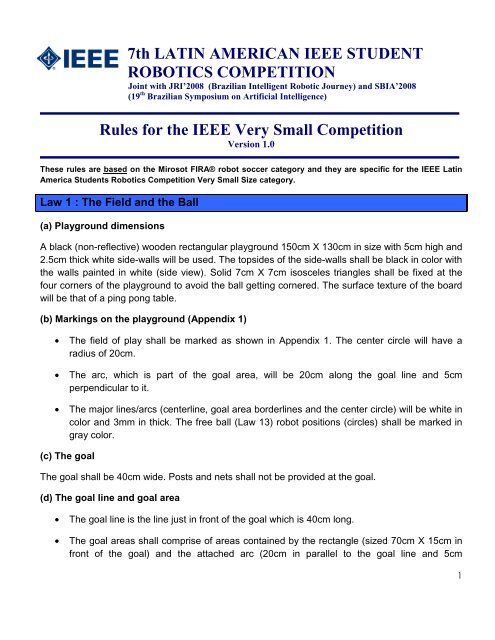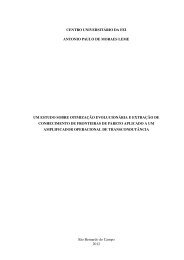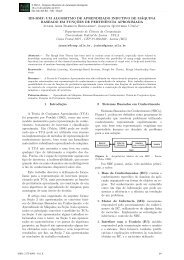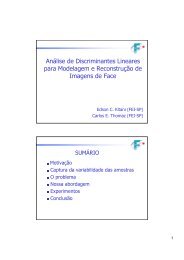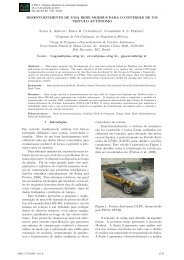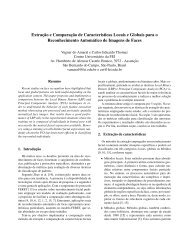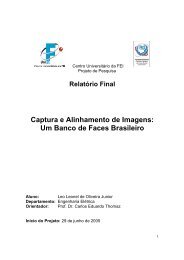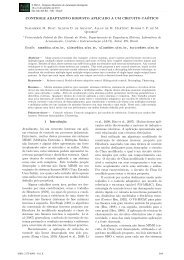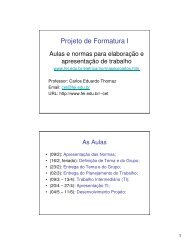Rules ? IEEE Very Small Category
Rules ? IEEE Very Small Category
Rules ? IEEE Very Small Category
Create successful ePaper yourself
Turn your PDF publications into a flip-book with our unique Google optimized e-Paper software.
7th LATIN AMERICAN <strong>IEEE</strong> STUDENT<br />
ROBOTICS COMPETITION<br />
Joint with JRI’2008 (Brazilian Intelligent Robotic Journey) and SBIA’2008<br />
(19 th Brazilian Symposium on Artificial Intelligence)<br />
<strong>Rules</strong> for the <strong>IEEE</strong> <strong>Very</strong> <strong>Small</strong> Competition<br />
Version 1.0<br />
These rules are based on the Mirosot FIRA® robot soccer category and they are specific for the <strong>IEEE</strong> Latin<br />
America Students Robotics Competition <strong>Very</strong> <strong>Small</strong> Size category.<br />
Law 1 : The Field and the Ball<br />
(a) Playground dimensions<br />
A black (non-reflective) wooden rectangular playground 150cm X 130cm in size with 5cm high and<br />
2.5cm thick white side-walls will be used. The topsides of the side-walls shall be black in color with<br />
the walls painted in white (side view). Solid 7cm X 7cm isosceles triangles shall be fixed at the<br />
four corners of the playground to avoid the ball getting cornered. The surface texture of the board<br />
will be that of a ping pong table.<br />
(b) Markings on the playground (Appendix 1)<br />
• The field of play shall be marked as shown in Appendix 1. The center circle will have a<br />
radius of 20cm.<br />
• The arc, which is part of the goal area, will be 20cm along the goal line and 5cm<br />
perpendicular to it.<br />
• The major lines/arcs (centerline, goal area borderlines and the center circle) will be white in<br />
color and 3mm in thick. The free ball (Law 13) robot positions (circles) shall be marked in<br />
gray color.<br />
(c) The goal<br />
The goal shall be 40cm wide. Posts and nets shall not be provided at the goal.<br />
(d) The goal line and goal area<br />
• The goal line is the line just in front of the goal which is 40cm long.<br />
• The goal areas shall comprise of areas contained by the rectangle (sized 70cm X 15cm in<br />
front of the goal) and the attached arc (20cm in parallel to the goal line and 5cm<br />
1
(e) The ball<br />
perpendicular to it).<br />
An orange golf ball shall be used as the ball, with 42.7mm diameter and 46g weight.<br />
(f) The field location<br />
The field shall be indoors.<br />
(g) The lighting condition<br />
The lighting condition in the competition site shall be fixed around 1,000 Lux.<br />
Law 2 : The Players<br />
(a) The overall system (Appendix 2)<br />
A match shall be played by two teams, each consisting of three robots. One of the robots can be<br />
the goalkeeper (Law 2.b.2). Three human team members, a "manager", a "coach" and a "trainer"<br />
shall only be allowed on stage. One host computer per team, mainly dedicated to vision<br />
processing and for location identifying, can be used.<br />
(b) The robots<br />
The size of each robot shall be limited to 7.5cm X 7.5cm X 7.5cm. The height of the RF<br />
communication antenna will not be considered in deciding a robot's size.<br />
The topside of a robot must not be colored in orange, white or gray nor must not be colored with<br />
more than two colors different from black. A color patch either blue or yellow, as assigned by the<br />
organizers, will identify the robots in a team. All the robots must have, visible on their top, a solid<br />
region of their team color patch, blue or yellow. This region can be of any shape, but must be able<br />
to contain (at least) a square with 3.5 cm of side or a circle with 4 cm of diameter. A team's<br />
identification color will change from game to game, and the team color patch used should be<br />
detachable. When assigned with one of the 2-team colors (blue or yellow), the robots must not<br />
have any visible patches of those colors used by an opponent team.<br />
Note : The teams are recommended to prepare a minimum of 2 blue patches and 2 yellow<br />
patches for competition. The teams are also recommended to prepare a minimum of 6 different<br />
color patches, other than blue and yellow, for individual robot identification.<br />
The robots should wear uniforms and the size of which shall be limited to 8cm X 8cm X 8cm.<br />
A robot within its own goal area (Law 1.d.) shall be considered as the "goalkeeper". The robot<br />
assuming the role of goalkeeper can be dynamically changed during the match, as the robot<br />
inside its own area (if any) will always be considered as the goalkeeper. The goalkeeper robot<br />
2
shall be allowed to catch or hold the ball only when it is inside its own goal area.<br />
Each robot must be fully independent, with powering and motoring mechanisms self-contained.<br />
Only wireless communication shall be allowed for all kinds of interactions between the host<br />
computer and a robot.<br />
The robots are allowed to equip with arms, legs, etc., but they must comply with the size<br />
restrictions (Law 2.b.1) even after the appendages fully expanded. None of the robots, except the<br />
single designated goalkeeper, shall be allowed to catch or hold the ball such that more than 30%<br />
of the ball is out of view either from the top or from the sides (Appendix 3).<br />
While a match is in progress, at any time the referee whistles the human operator should stop all<br />
robots using the communication between the robots and the host computer.<br />
(c) Substitutions<br />
Two substitutes shall be permitted while a game is in progress. At half time, unlimited substitutions<br />
can be made. When a substitution is desired while the game is in progress, the concerned team<br />
manager should call 'time-out' to notify the referee, and the referee will stop the game at an<br />
appropriate moment. The game will restart, with all the robots and the ball placed at the same<br />
positions as they were occupying at the time of interrupting the game.<br />
(d) Time-out<br />
The human operator can call for 'time-out' to notify the referee. Each team will be entitled for two<br />
time-outs in a game and each shall be of 2 minutes duration.<br />
Law 3 : Transmissible Information<br />
The manager, the coach or the trainer may transmit certain commands directly from the remote<br />
host computer to their robots only when authorized by the referee or when the game is not in<br />
progress. It is not allowed to transmit commands such as reset signals to stop any/all of the robots<br />
or restart signals, without the permission from the referee. Any other information, such as game<br />
strategy, can be communicated to robots only when a game is not in progress. The human<br />
operator should not directly control the motion of their robots either with a joystick or by keyboard<br />
commands under any circumstances. While a game is in progress the host computer can send<br />
any information autonomously.<br />
Law 4 : The Vision System (Appendix 3)<br />
In order to identify the robots and the ball on the playground, a vision system can be used. The<br />
location of a team's camera or sensor system should be restricted to, over and above their own<br />
half of the field including the center line, so that the camera need not has to be moved after the<br />
side change at halftime. If both teams wish to keep their cameras over and above the center circle<br />
3
of the playground, they shall be placed side by side, equidistant from the centerline and as close<br />
to each other as possible. The location of the overhead camera or sensor system should be at a<br />
height of 2m or higher.<br />
Law 5 : Game Duration<br />
The duration of a game shall be two equal periods of 5 minutes each, with a half time interval for<br />
10 minutes.<br />
An official timekeeper will pause the clock during substitutions, while transporting an injured robot<br />
from the field, during time-out and during such situations that deem to be right as per the<br />
discretion of the timekeeper.<br />
If a team is not ready to resume the game after the half time, additional 5 minutes shall be<br />
allowed. Even after the allowed additional time if such a team is not ready to continue the game,<br />
that team will be disqualified from the game.<br />
Law 6 : Game Commencement<br />
Before the commencement of a game, either the team color (blue/yellow) or the ball shall be<br />
decided by the toss of a coin. The team that wins the toss shall be allowed to choose either their<br />
robot's identification color (blue/yellow) or the ball. The team who receives the ball shall be<br />
allowed to opt for their carrier frequency band as well.<br />
At the commencement of the game, the attacking team will be allowed to position their robots<br />
freely in their own area and within the center circle. Then the defending team can place their<br />
robots freely in their own area except within the center circle.<br />
At the beginning of the first and second halves and after a goal has been scored, the ball should<br />
be kept within the center circle. With a signal from the referee, the game shall be started and all<br />
robots may move freely.<br />
At the beginning of the game or after a goal has been scored, the game shall be<br />
commenced/continued, with the positions of the robots as described in Law 6.2.<br />
After the half time, the teams have to change their sides.<br />
Law 7 : Method of Scoring<br />
(a) The Winner<br />
A goal shall be scored when the whole of the ball passes over the goal line. The winner of a game<br />
shall be decided on the basis of the number of goals scored.<br />
(b) The Tiebreaker<br />
4
In the event of a tie after the second half and if the rules of the competition do not allow a tie to<br />
happen in this specific match, the winner will be decided by the sudden death scheme. The game<br />
will be continued after a 5 minutes break, for a maximum period of three minutes. The team<br />
managing to score the first goal will be declared as the winner. If the tie persists even after the<br />
extra 3 minutes game, the winner shall be decided through penalty-kicks. Each team shall take<br />
three penalty-kicks, which differs from Law 11 as only a kicker and a goalkeeper shall be allowed<br />
on the playground. The goalkeeper should be kept within its goal area and the positions of the<br />
kicker and of the ball shall be the same as per the Law 11. After the referee's whistle, the<br />
goalkeeper may come out of the goal area. In case of a tie even after the three-time penaltykicks,<br />
additional penalty-kicks shall be allowed one-by-one, until the winner can be decided. All penaltykicks<br />
shall be taken by a single robot and shall commence with the referee's whistle. A penaltykick<br />
will be completed, when any one of the following happens:<br />
• The goalkeeper catches the ball with its appendages (if any) in the goal area.<br />
• The ball comes out of goal area.<br />
• Thirty (30) seconds pass after the referee's whistle.<br />
Law 8 : Fouls<br />
A foul will be called for in the following cases:<br />
Colliding with a robot of the opposite team: the referee will call such fouls that directly affect the<br />
play of the game or that appear to have potential to harm the opponent robot. When a defender<br />
robot pushes an opponent robot without the ball, a free kick will be given to the opposite team if<br />
the referee considers that the foul is relevant to the match. It is permitted to push the ball and an<br />
opponent player backwards provided the pushing player is always in contact with the ball.<br />
It is permitted to push the goalkeeper robot in the goal area, if the ball is between the pushing<br />
robot and the goalkeeper. However, pushing the goalkeeper into the goal along with the ball is not<br />
allowed. If an attacking robot pushes the goalkeeper along with the ball into the goal or when the<br />
opponent robot pushes the goalkeeper directly then the referee shall call goal kick as goalkeeper<br />
charging.<br />
Attacking with more than one robot in the goal area of the opposite team shall be penalized by a<br />
goal kick to be taken by the team of the goalkeeper. A robot is considered to be in the goal area if<br />
it is more than 50% inside, as judged by the referee.<br />
Defending with more than one robot in the goal area when the ball is inside the goal area shall be<br />
penalized by a penalty-kick, except if a goal is scored by the attacking team. A robot is considered<br />
to be in the goal area if it is more than 50% inside, as judged by the referee. If the ball enters<br />
inside the goal area where there are two defending robots or if a second defending robot enters<br />
inside the goal area where there are already the goalkeeper and the ball, the referee must<br />
5
penalize the defending team with a penalty kick to the opposite team. If the ball is not in the goal<br />
area, there are no penalizations for teams with two defending robots inside its own goal area.<br />
It is referred to as handling, as judged by the referee, when a robot other than the goalkeeper<br />
catches the ball. The ball is considered caught when a robot firmly attaches itself to the ball in<br />
such a way that no other robot can move the ball. The team will be penalized with a free kick if the<br />
infraction happens outside its own goal area or with a penalty kick if it happens inside its own goal<br />
area.<br />
When the goalkeeper controls the ball without dispute, it must kick out the ball from its goal area<br />
(Law 1.d.) within 10 seconds. The failure to do so will be penalized by giving a penalty kick to the<br />
opposite team. If an attacking robot disputes the ball with the goalkeeper during this time, the time<br />
count is restarted. Giving a goal kick to the team of the goalkeeper will penalize the blocking of a<br />
goalkeeper in its goal area. Only the referee and one of the human members of a team (manager,<br />
coach or trainer) shall be allowed to touch the robots. The award of a penalty-kick shall penalize<br />
touching the robots without the referee's permission.<br />
Law 9 : Play Interruptions<br />
The play shall be interrupted and relocation of robots shall be done only when:<br />
• A robot has to be changed.<br />
• A robot has fallen in such a way as to block the goal.<br />
• A goal is scored or a foul occurs.<br />
• Referee calls free kick (Law 10), penalty kick (Law 11), goal kick (Law 12) or free-ball (Law<br />
13).<br />
The robots can be relocated by a human operator or by their own means. When the referee calls<br />
free-ball, the relocation by humans is not allowed, as presented in Law 13.<br />
Law 10 : Free Kick (Appendix 4)<br />
When a defender robot pushes an opponent robot, a free kick will be given to the opposite team<br />
(Law 8.1.).<br />
The ball will be placed at the relevant free kick position (FK) on the playground (Appendix 1). The<br />
robot taking the kick shall be placed behind the ball. The attacking team can position its robots<br />
freely within its own side. The defending robots shall be placed in touch with the goal area on<br />
either side of the arc. With the referee's whistle all robots can start moving freely.<br />
Law 11 : Penalty-Kick (Appendix 5)<br />
6
A penalty-kick will be called under the following situations.<br />
• Defending with more than one robot in a goal area (Law 8.4.).<br />
• Failure on the part of a goalkeeper to kick out the ball from its goal area within 10 seconds<br />
(Law 8.6.).<br />
• When any one of the human members touches the robots without the referee's permission,<br />
while the game is in progress (Law 8.8.).<br />
When the referee calls a penalty-kick, the ball will be placed at the relevant penalty kick position<br />
(PK) on the playground (Appendix 1). The robot taking the kick shall be placed behind the ball.<br />
While facing a penalty kick one of the sides of the goalkeeper must be in touch with the goal line.<br />
The goalkeeper may be oriented in any direction. Other robots shall be placed freely within the<br />
other side of the half-line, but the attacking team will get preference in positioning their robots. The<br />
game shall restart normally (all robots shall start moving freely) after the referee's whistle. The<br />
robot taking the penalty-kick may kick or dribble the ball.<br />
Law 12 : Goal Kick (Appendix 6)<br />
A goal kick will be called under the following situations:<br />
• When an attacking robot pushes the goalkeeper in its goal area, the referee shall call goal<br />
kick as goalkeeper charging (Law 8.2.).<br />
• Attacking with more than one robot in the goal area of the opposite team shall be penalized<br />
by a goal kick to be taken by the opposite team (Law 8.3.).<br />
• When an opponent robot blocks the goalkeeper in its goal area (Law 8.7.).<br />
• When the goalkeeper catches the ball with its appendages (if any) in its own goal area.<br />
• When a stalemate occurs in the goal area for 10 seconds.<br />
During goal kick only the goalkeeper will be allowed within the goal area and the ball can be<br />
placed anywhere within the goal area. Other robots of the team shall be placed outside the goal<br />
area during goal kick. The attacking team will get preference in positioning their robots anywhere<br />
on the playground, but it must be as per Law 8.3. The defending team can then place its robots<br />
within their own side of the playground. The game shall restart with the referee's whistle.<br />
Law 13 : Free-Ball (Appendix 7)<br />
The referee will call a free-ball when a stalemate occurs for 10 seconds outside the goal areas. In<br />
this case, the robots can only be relocated by their own means or by the referee, and not by a<br />
human member of the team.<br />
7
When a free-ball is called within any quarter of the playground, the robots must stop and the ball<br />
will be placed by the referee at the relevant free ball position (FB) (Appendix 1). The referee must<br />
also manually relocate all the robots which are less than 20cm of distance from the relevant free<br />
ball mark, longitudinally moving the robots toward their own field until they are aligned with the<br />
relevant free ball robot positions (gray circles), located 20cm apart from the ball position in the<br />
longitudinal direction of the playground. After that, one (or none) robot per team can automatically<br />
place itself at the relevant free ball robot position (gray circle) nearest its own goal. The other<br />
robots (of both teams) must stay where they are. The game shall resume when the referee gives<br />
the signal and all robots may then move freely.<br />
8
[Appendix 1] ARENA DIMENSIONS<br />
9
[Appendix 2]<br />
[Appendix 3]<br />
10
[Appendix 4]<br />
11
[Appendix 5]<br />
12
[Appendix 6]<br />
13
[Appendix 7]<br />
14


